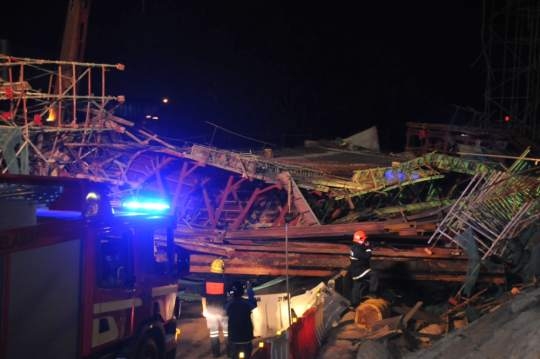 GEORGE TOWN (Nov 2): The fatal Second Penang Bridge scaffold collapse and the Menara Umno fin wall collapse in June 2013 could and should had been prevented if “gross human errors were not committed”, said a Penang Commission of Inquiry report on the two incidents.
GEORGE TOWN (Nov 2): The fatal Second Penang Bridge scaffold collapse and the Menara Umno fin wall collapse in June 2013 could and should had been prevented if “gross human errors were not committed”, said a Penang Commission of Inquiry report on the two incidents.
In the first incident, scaffold supporting construction of the Second Penang Bridge killed a passing motorist when it collapsed in the evening of June 6, 2013.
A week later, the collapse of the fin wall from the roof of the 21-storey tower during a storm killed two people: lorry attendant Jahir Hussain Sulaiman and a passing driver Lim Chin Aik. The fin wall fell directly on top of the driver and his car. Parts of the smashed car were recovered from the site after days of search but Lim’s body was never recovered.
The commission – chaired by former Malaysian Bar head Datuk Yeoh Yang Poh and including well-known engineering professionals Datuk Dr Gue See Sew and Datuk Professor Roslan Hashim – stated that the collapse of the scaffold at Piers 6 and 7 of Ramp 2 in Batu Maung was caused by its “severely faulty or defective construction”.
“In at least some of the installations, diagonal bracings were totally absent in the transverse direction. They were simply not constructed; even though the design drawings had indicated that they were supposed to be there.
“This was the most serious of the numerous errors in the installation because this alone would have been sufficient to cause the failure of the scaffold,” the report said, adding that the omission of the diagonal bracings had reduced the load-bearing capacity.
The report, which was given to the media today by the Chief Minister’s Office, also noted that the structure was a heavy scaffold that had to be able to support a large amount of weight during the construction.
It also said there was absence of proper supervision of temporary works, which the commission remarked was “not treated with the same degree of respect accorded to permanent works”.
The report also stated that the scaffold was not erected under the supervision of the professional engineer who had signed and endorsed the design, and that the scaffold supervisor who certified its safety did not know how to read engineering drawings.
The commission also named the parties responsible or had contributed to the failure of the collapsed scaffold - the subcontractor, the main contractor, the supervision consultants, the superintending officer from the bridge developer, the professional engineer, who signed and endorsed the scaffold design; and the scaffold inspector.
On the Menara Umno incident, the report stated that the collapse of the fin wall was due to the failure of the 200-tonne structure, which was designed with engineering knowledge that was “decades old”.
“In 1995, when the fin wall was designed; frequency, resonance and amplification were decades-old engineering knowledge. They were matters that a design engineer in 1995 ought to have taken into consideration.”
The report said the engineer, who had no experience in designing a slender cantilever column on top of a tall building, was incompetent and grossly negligent, and committed multiple serious errors when designing the fin wall.
The report earlier explained that the gust-speed wind at the building during the time of the incident on June 13 two years ago, was around 18m/s, which was far from the highest recorded speed for the island.
It also noted that the wind was blowing from the direction of 320 degrees, which was perpendicular to the weaker axis of the reinforced-concrete fin wall, a feature wall.
The report also listed down a series of recommendations by the commission, such as local planning authorities should in future require engineers to check and certify in writing the expected natural frequency of a tall building structure.
It also recommended that the state government set up a committee to study and implement logistical and other planning, in order to better prepare for future emergencies; and the police should be trained to be more disciplined and proactive in carrying out their duties during emergencies, among others.
“A properly designed fin wall of that nature should have been able to withstand, at the very least, gust-speeds of 27m/s.
“In engineering terms, the failure of the fin wall means that its total bending moments at the time of failure had exceeded its bending capacity. In laymen terms, the wind at the time of the incident had made the fin wall deflect or bend in the direction of the wind, to an extent greater than it could manage.” -- The Malaysian Insider





